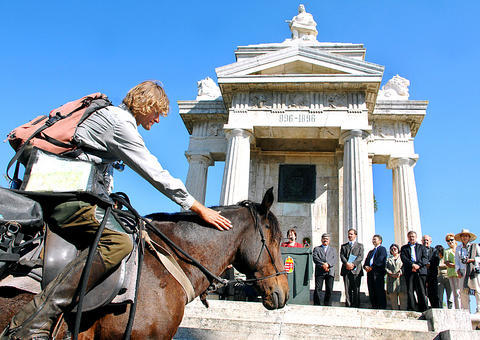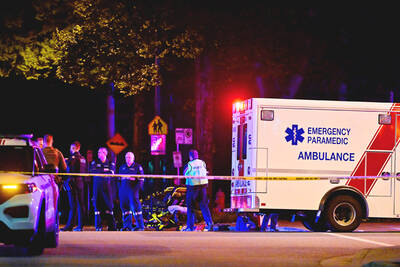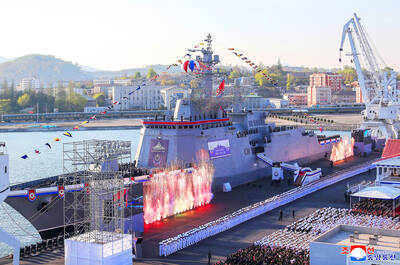Scaring off wolves with firecrackers and resuscitating a dog with raw eggs and vodka are just two of the wild experiences of Tim Cope during his 10,000km journey on horseback from Mongolia to Hungary.
Cope, 28, a native of the Gippsland region of southeast Australia, described his expedition of more than three years -- officially billed as "On the Trail of Genghis Khan" -- as a tribute to the nomadic people from Central Asia who over the centuries made their way west toward Europe.
Cope arrived at the journey's end point, the Hungarian town of Opusztaszer, on Saturday.

PHOTO: AP
"I'm very happy to be here," Cope said, surrounded by his traveling companions -- his dog and three horses. "Sometimes I didn't think I would ever arrive."
He described those who opened their doors to him during the trip and his animals as the "real heroes" of the adventure.
He started out in Mongolia in June 2004 and later crossed through Kazakhstan, southern Russia, Ukraine and, for the last two months, Hungary.
Cope initially expected to spend 18 months on horseback retracing the road of the Avars, Mongols and Huns, among others, but the trip ended up taking more than twice as long.
"I'm feeling a bit panicky about finishing because I can't imagine saying goodbye to the horses," Cope said by telephone on Friday, resting with his animals not far from Opusztaszer. "It's become my way of life for the last three years."
According to Hungarian tradition, the leaders of the Magyar tribes, which arrived in the region from Central Asia at the end of the 9th century, met in Opusztaszer -- about 140km south of Budapest, the capital -- to divide up the land among themselves.
"Here at the Danube River is where the Eurasian steppe ends, with its beginning in Mongolia and Manchuria," Cope said. "Farther west the landscape changes, so Opusztaszer is the perfect ending symbolically and geographically."
The Mongolian conqueror Genghis Khan extended his conquests into Central Asia and raided Eastern Europe in the early 13th century.
Cope, using one horse as his mount and two to carry supplies and feed, eventually needed 13 horses to complete the journey, although two of them -- Taskonir and Ogonyok -- have accompanied him since October 2004 all the way from Kazakhstan.
Also along for the ride -- although he had to walk -- was Tigon, a black Kazakh hunting dog, whose name means "hawk" or "fast wind." Cope was given Tigon as a gift in Kazakhstan and he hopes to take him home to Australia.
Like all the members of the team, Tigon had some incredible experiences during the journey, like the time he was stolen from Cope only to be found locked in a mine shaft, lying on ice and nearly frozen to death.
It took hours of care in a hot sauna, being fed with raw eggs and vodka, and then three more weeks of pampering before Tigon was again ready to go.
About half of the journey was through the steppe in Kazakhstan, where Cope was able to recreate most closely the nomadic lifestyle.
"It's very open landscape with extremely harsh conditions and good for grazing. It kind of dictates a nomad way of life," he said, describing having to endure temperatures ranging from minus 52oC to plus 54oC.
Cope often relied on the kindness and hospitality of strangers for food and shelter and reckoned he spent about half of his nights in his tent and the rest in farm houses, huts and yurts of strangers along the way.
Cope took gifts from Australia to exchange with his hosts and gave away many hundreds of photographs.
Late last year, he suspended the trip for several months to return to Australia when his father was killed in a car crash not far from the family home.
During his trip home his three horses stayed in Ukraine and he returned only to find them in poor condition.
"I had to cradle them back to health and it was like starting all over again," Cope said. "It was the toughest part of the journey."
Cope said his priority after getting hom would be to complete a book and a film about his voyage.
"It's my way of life, it was not just a trip," Cope said. "I'll be back in the saddle as soon as I can."

Archeologists in Peru on Thursday said they found the 5,000-year-old remains of a noblewoman at the sacred city of Caral, revealing the important role played by women in the oldest center of civilization in the Americas. “What has been discovered corresponds to a woman who apparently had elevated status, an elite woman,” archeologist David Palomino said. The mummy was found in Aspero, a sacred site within the city of Caral that was a garbage dump for more than 30 years until becoming an archeological site in the 1990s. Palomino said the carefully preserved remains, dating to 3,000BC, contained skin, part of the

TRUMP EFFECT: The win capped one of the most dramatic turnarounds in Canadian political history after the Conservatives had led the Liberals by more than 20 points Canadian Prime Minister Mark Carney yesterday pledged to win US President Donald Trump’s trade war after winning Canada’s election and leading his Liberal Party to another term in power. Following a campaign dominated by Trump’s tariffs and annexation threats, Carney promised to chart “a new path forward” in a world “fundamentally changed” by a US that is newly hostile to free trade. “We are over the shock of the American betrayal, but we should never forget the lessons,” said Carney, who led the central banks of Canada and the UK before entering politics earlier this year. “We will win this trade war and

‘BODIES EVERYWHERE’: The incident occurred at a Filipino festival celebrating an anti-colonial leader, with the driver described as a ‘lone suspect’ known to police Canadian police arrested a man on Saturday after a car plowed into a street party in the western Canadian city of Vancouver, killing a number of people. Authorities said the incident happened shortly after 8pm in Vancouver’s Sunset on Fraser neighborhood as members of the Filipino community gathered to celebrate Lapu Lapu Day. The festival, which commemorates a Filipino anti-colonial leader from the 16th century, falls this year on the weekend before Canada’s election. A 30-year-old local man was arrested at the scene, Vancouver police wrote on X. The driver was a “lone suspect” known to police, a police spokesperson told journalists at the

North Korean leader Kim Jong-un has unveiled a new naval destroyer, claiming it as a significant advancement toward his goal of expanding the operational range and preemptive strike capabilities of his nuclear-armed military, state media said yesterday. North Korea’s state-run Korean Central News Agency (KCNA) said Kim attended the launching ceremony for the 5,000-tonne warship on Friday at the western port of Nampo. Kim framed the arms buildup as a response to perceived threats from the US and its allies in Asia, who have been expanding joint military exercises amid rising tensions over the North’s nuclear program. He added that the acquisition